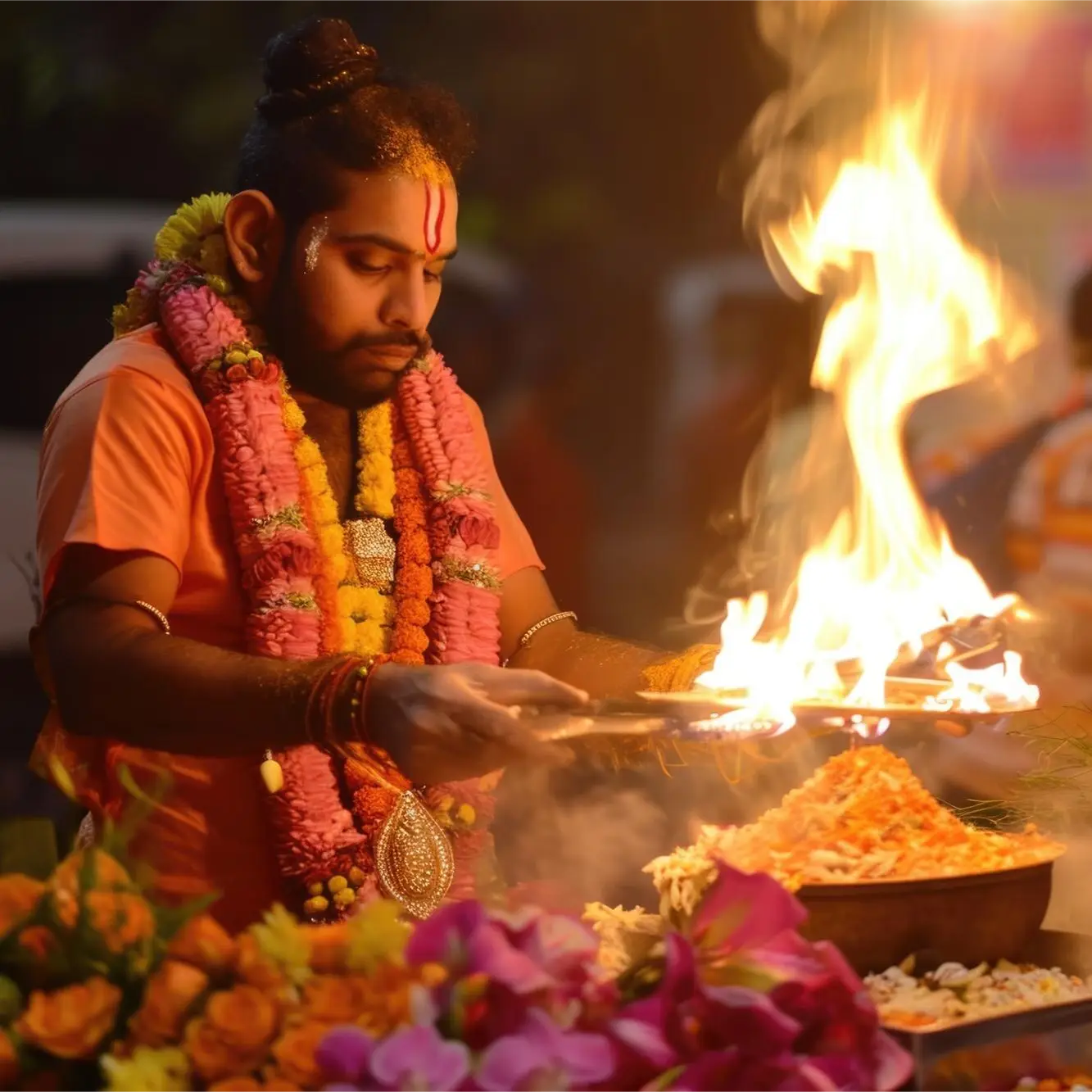Introduction
Hindu priests, known as Pujaris or Pandits, play a crucial role in Hinduism. They do more than just perform rituals; they also uphold traditions and teach spirituality.
This article will explore the various responsibilities of Hindu priests, including their history, education, lifestyle, and changing roles in society. Understanding this topic will shed light on the importance of Hindu priests in nurturing community spirituality and preserving ancient customs.
The Role of Hindu Priests in Religious Practices
Hindu priests, known as Pujaris and Pandits, play a crucial role in Hindu worship by performing important rituals and ceremonies. These activities are the foundation of religious practices and have a significant impact on the spiritual lives of individuals and communities.
Responsibilities of Hindu Priests
Hindu priests have various responsibilities that cover different aspects of religious life:
- Daily Prayers: Every morning and evening, priests conduct rituals that involve making offerings to deities. This ensures that devotees maintain a daily spiritual connection.
- Festivals: Major celebrations such as Diwali and Navaratri require careful planning and execution of intricate rituals. Priests play a key role in bringing communities together during these festive times.
- Weddings: Priests officiate at marriages, performing sacred rites that unite couples in a spiritual bond.
- Significant Life Events: Ceremonies marking births, naming ceremonies, and funerals are conducted with great respect by priests.
Types of Rituals Conducted by Hindu Priests
Hindu priests perform various types of rituals to cater to the needs of individuals and the community:
- Pujas: These worship ceremonies can range from simple offerings to elaborate festivals. They are customized according to specific deities and occasions.
- Homams: Fire rituals known as Homams symbolize purification and involve making offerings to the divine. These rituals are often performed during important events.
- Chanting Mantras: Reciting sacred texts, or mantras, is an integral part of Hindu rituals. It helps invoke blessings and creates a spiritual atmosphere.
The Impact of Hindu Priests' Practices
The practices carried out by Hindu priests have far-reaching effects:
- Personal Devotion: Through their guidance, priests facilitate individual worship and devotion towards deities.
- Community Bonds: The collective participation in rituals strengthens the sense of belongingness among community members.
- Preservation of Traditions: Priests play a vital role in passing down age-old customs and traditions from one generation to another.
In summary, Hindu priests serve as intermediaries between devotees and the divine. Their expertise in performing rituals not only nurtures personal spirituality but also fosters harmony within communities.
Historical Context of Hindu Priesthood
The historical roots of Hindu priesthood trace back to the Brahmin varna, a social class traditionally associated with spiritual leadership and education. This class has played a crucial role in preserving and transmitting sacred knowledge through generations.
Origins and Traditions
The priestly duties are deeply embedded in ancient texts, such as the Vedas, which outline rituals and ceremonies. Initially, Brahmins were the sole custodians of these practices, ensuring that religious traditions were upheld within society.
Evolution Over Time
Through centuries, the role of Hindu priests has adapted, reflecting broader societal changes. The emergence of various sects and communities has led to an expansion of priestly functions beyond the Brahmin class.
Inclusivity Beyond Brahmins
Today, non-Brahmin priests serve in various communities, highlighting a shift towards inclusivity within Hinduism. Individuals from diverse backgrounds conduct rituals, reflecting local customs and beliefs. This evolution enhances the richness of religious practices across different sects.
Understanding this historical context provides insight into the dynamic nature of Hindu priesthood and its ongoing relevance in contemporary society.
Education and Knowledge of Hindu Priests
Hindu priests, often referred to as Pujaris or Pandits, undergo rigorous training in sacred texts to fulfill their roles effectively. Their education primarily focuses on:
1. Study and Mastery
- Mastering the Vedas and Dharmashastras is essential for understanding the principles of Hinduism.
- These texts provide guidance on rituals, ethics, and spiritual practices, ensuring priests are well-equipped to lead ceremonies.
2. Roles in Teaching
- Beyond performing rituals, priests serve as educators within their communities.
- They explain the teachings found in key scriptures, helping devotees connect with their faith.
Community engagement plays a vital role in the responsibilities of Hindu priests. They actively participate in educating devotees about significant texts such as:
1. Bhagavad Gita
This scripture emphasizes duty, righteousness, and devotion, offering practical insights into life’s challenges.
2. Ramayana
Through storytelling and discussions, priests illuminate the lessons of virtue, loyalty, and dharma found within this epic.
This commitment to education empowers both priests and devotees, fostering a deeper understanding of Hindu philosophy and spirituality. The knowledge shared by priests enhances community bonds and nurtures an informed religious environment.
Purity Standards and Lifestyle Choices of Hindu Priests
Hindu priests, or Pujaris, follow strict purity standards that affect their daily lives and rituals. These standards are based on the belief that staying spiritually clean is crucial for effective worship and guidance within the community.
Dietary Restrictions
A significant aspect of a priest's lifestyle is the commitment to vegetarianism. This abstinence is not merely a personal choice but a reflection of their role as custodians of spiritual practices. The consumption of meat and alcohol is seen as detrimental to purity, hence priests focus on a diet that supports their spiritual duties.
Financial Aspects
Unlike many professions, Hindu priests do not charge fees for their services. Instead, they rely on alms and donations from the community. This practice fosters a relationship of trust and respect between the priest and devotees, emphasizing the communal aspect of ritualistic practices. Such financial choices further highlight their commitment to serving the spiritual needs of others without seeking personal gain.
These lifestyle choices are integral to the identity of Hindu priests, shaping their roles as spiritual leaders committed to upholding tradition and purity in service to their communities.
The Evolving Role of Women as Hindu Priests
The world of Hindu priesthood is undergoing a significant change with the increasing recognition of women priests. This sacred profession, traditionally dominated by men, is gradually opening doors for women, challenging deeply ingrained gender roles within society.
Key developments include:
- Emergence of Women Priests: Various temples in India and abroad now embrace female priests, acknowledging their spiritual capabilities.
- Community Support: Grassroots organizations and movements actively promote inclusivity, advocating for women's participation in rituals and ceremonies.
- Changing Perceptions: Families are beginning to support daughters and sisters pursuing priesthood, highlighting a shift towards gender equality in sacred duties.
This evolution not only enriches the religious experience but also empowers women within their communities. The visibility of women priests encourages dialogue around inclusivity, further redefining what it means to be a spiritual leader in contemporary Hinduism.
Architectural Contributions of Hindu Priests to Temple Design
Hindu priests, especially those known as Sthapatis, play a vital role in the world of temple architecture. They are in charge of designing and building temples based on sacred guidelines found in Vaastu Shastra, an ancient architectural science that focuses on creating harmony and balance.
Key contributions include:
- Designing Temples: Sthapatis make sure that temple layouts follow cosmic principles, creating a spiritually uplifting atmosphere.
- Material Selection: Priests help choose materials that hold spiritual significance.
- Ritual Integration: Architectural features are crafted to accommodate various rituals performed by priests, enriching the worship experience.
The knowledge of Hindu priests in temple design not only shows their profound understanding of religious texts but also strengthens their position as guardians of tradition within the community. Their efforts create environments where spirituality flourishes.
Conclusion: The Enduring Significance of Hindu Priests in Society Today
The significance of Hindu priests extends far beyond their ritualistic roles. They embody essential duties that contribute to:
- Community Life: Engaging with devotees, fostering a sense of belonging and spiritual connection.
- Spirituality: Guiding individuals through life's milestones with profound rituals and teachings.
- Custodians of Tradition: Preserving ancient practices and ensuring the transmission of sacred knowledge.
Their influence reaches into everyday life, reinforcing values, ethics, and cultural heritage.
Readers are encouraged to explore further by attending local temple events or engaging with community activities. Discovering the world of Hindu priests can deepen your understanding of spirituality and cultural traditions. Connecting with these figures not only enriches personal faith but also strengthens communal bonds, highlighting the enduring role of Hindu priests in today’s society.




















